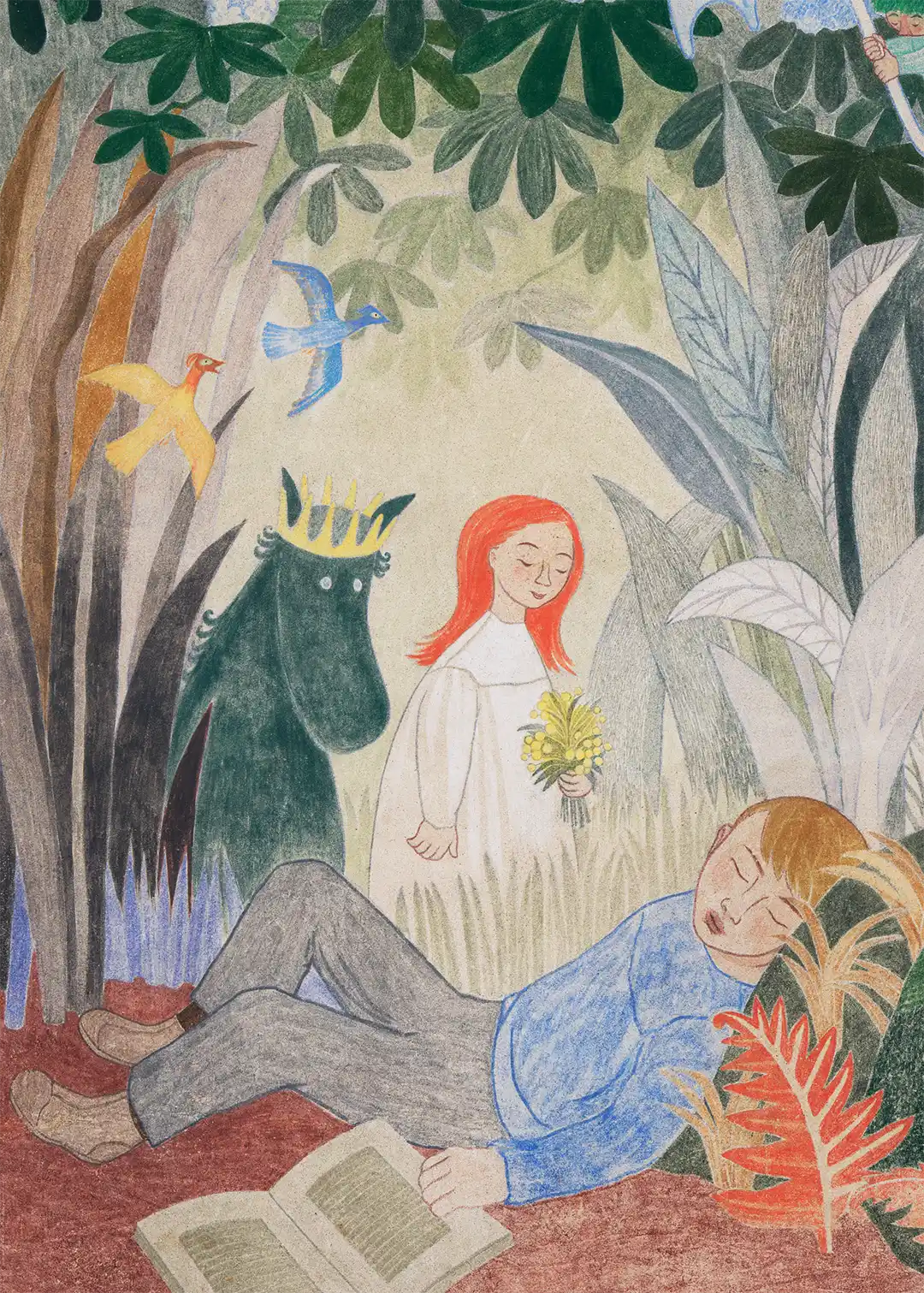Tove Jansson and the Moomins: The Door Is Always Open. Brooklyn, New York: Brooklyn Public Library. June 28 - September 30, 2025. https://www.bklynlibrary.org/exhibitions/tove-jansson-and-the-moomins
For
the summer of 2025, Brooklyn Public Library hosted Tove Jansson and the
Moomins: The Door Is Always Open, in honor of the 80th anniversary of the
publication of the first Moomin book, The
Moomins and the Great Flood. Covering both Jansson’s life and the Moomins’
place in international popular culture, this exhibit was claimed to be the
first U.S. exhibit to focus on the Moomins and their creator, Jansson.[1] The
exhibition was spread throughout, and even outside, the Central Library space.
When approaching the library, visitors were immediately drawn in by Moomin
characters decorating the windows of the Children’s Room and, at night,
projected on the outside of the building on either side of the main entrance.
Once
inside, the exhibit was divided across multiple areas of the Central Library.
In the lobby just inside the main entrance, two large displays featured
Jansson’s book, with one to the left focused on her Moomin books and one to the
right highlighting her adult fiction. These displays featured multiple editions
of the books in multiple languages to show the international impact Jansson’s
writing and illustrations have had.


The
exhibit continued on the second floor in display cases that lined the balcony
overlooking the lobby. These cases included materials related to both Jansson
and the Moomins. On one side of the balcony, two examples of Jansson’s other
artistic work were displayed alongside letters she wrote to friend and fellow
artist Eva Konikoff during Konikoff’s time in New York City. These letters
provided a personal insight into Jansson’s life during the early 1940s and also
show a connection to the city hosting the exhibit.
To
the left side of the balcony, several cases highlighted a selection of the
products that have featured the Moomins, showing the impressive range of
products that have incorporated these characters. These included ceramics by
Arabia, created with designs by Jansson’s partner, Tuulikki Pietilä,
collectibles released in partnership with Finnair, licensed clothing and
jewelry featuring the characters, and a variety of types of toys. Another case
focused specifically on the various media that Moomins have appeared in with
plays, LPs, games, and cartoons all represented from around the world. This
section of the exhibit impressed upon viewers the global reach the characters
have had and also the careful stewardship that Jansson and her family have
exerted over their licensing.
The
exhibit delved fairly deeply into Jansson’s biography to offer context for her
work and it was this component of the exhibit that probably interested those
who have an existing knowledge of the Moomins the most. While the Moomins may
be the most eye-catching element of the exhibition, the archival images of
Jansson brought her to life in a way that many readers of the Moomin books may
not have experienced in the past. Explanatory text introduced viewers to
Jansson’s life as a child and offered context for her decision to start working
as a freelance editor at age fifteen to help support her family and lessen the
burden on her mother, the family’s primary breadwinner. Though this exhibit focused
on the Moomins, it went well beyond these characters to explore Jansson’s
larger artistic life, highlighting her work as a painter, illustrator for
others’ works, and writing for both children and adults. Painting, in
particular, was important to Jansson throughout her life and the exhibit made
this clear in multiple locations, including by displaying her palette and
examples of her paintings.
The exhibit was complemented by programming, not only at the Central Library, but also at other branches of the Brooklyn Public Library system. These programs included children’s craft programs, and programs for adults. On September 16th, Jansson’s niece, Sophia Jansson, was scheduled to lead a guided tour of the exhibit.[2] As an exhibition hosted by a library, it is no surprise that Jansson’s works were also available in multiple languages for browsing in the library as part of multiple displays across the library and for checkout. These books included not only the Moomin novels, but also her adult fiction and books about her life. Offering these options for library patrons gave those who visited the exhibit a chance to immediately dive into the Moomins’ world and learn more about Jansson’s life and work, which is sure to lead to more lifelong fans. If you’re already a fan of the characters and their author, this exhibit was a worthy glimpse into the 80-year history of the Moomins and the important and impactful life of their creator.
[1] Moomin
80. June 6, 2025. The First Ever Moomin and Tove Jansson Exhibition in the U.S.
Opens at Brooklyn Public Library. Available at https://www.moomin.com/en/blog/brooklyn-public-library-moomin/#02ac7e82 .
Accessed July 3, 2025. However in 2021, IJOCA ran a review of a Moomin exhibit
in Washington, DC that can be found at https://ijoca.blogspot.com/2021/12/exhibit-review-moomin-animations.html
[2] Brooklyn
Public Library. nd. Tour of Tove Jansson & The Moomins. Available at
https://www.bklynlibrary.org/calendar/tour-tove-jansson-moomins-central-library-dweck-20250916-0700pm.
Accessed July 3, 2025.































